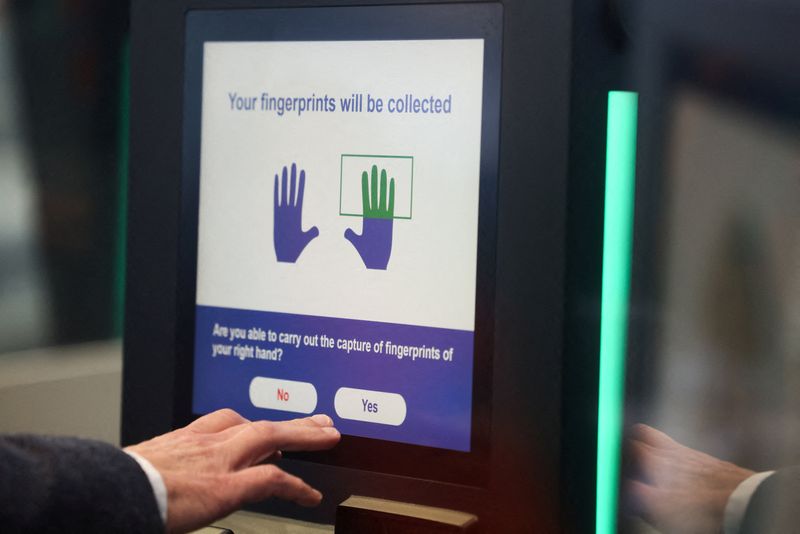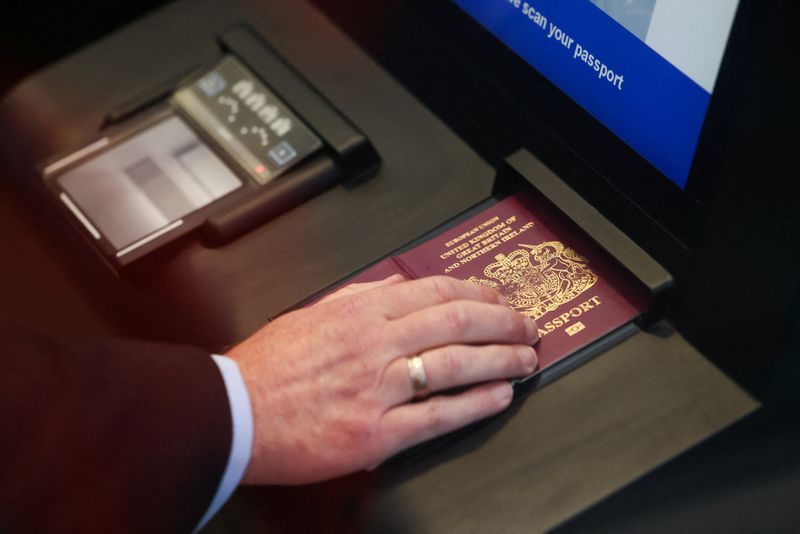By James Davey
LONDON (Reuters) -How all non-European Union citizens, including British visitors, travel to and from the bloc will start to change from Sunday when its long-delayed new biometric entry-check system starts operations.

The Entry/Exit System (EES) will require all non-EU citizens to register their personal details, including fingerprints and facial images, when they first enter the Schengen area – all EU nations apart from Ireland and Cyprus, plus Iceland, Norway, Switzerland and Liechtenstein.
Data collection will be gradually introduced at border crossings with full implementation by April 10, 2026, giving the EU confidence there will not be long queues at the border.
WHY IS THE EU MAKING THE CHANGES?
The new electronic system will remove the requirement to manually stamp passports at the EU’s external border and instead create digital records that link a travel document to a person’s identity using biometrics.
The EU wants to modernise the management of its external borders, prevent illegal migration, combat identity fraud, and identify overstayers.
It will monitor whether people who are travelling to the bloc without a visa are sticking to its up-to-90 days stay within any 180-day period rule.
WHAT WILL HAPPEN?
Anyone arriving in the Schengen area for the first time will have to scan their passports, register their fingerprints and provide a facial scan.
On departure, travellers’ details will be checked against the EES database to confirm compliance with existing rules on time limits of stay and register departure.
Subsequent journeys will only require facial biometric verification.
Children under 12 will need to be registered under EES but will just have their photograph taken. Travellers do not have to pay for EES.
WHERE WILL THE CHECKS HAPPEN?
On arrival at international airports, ports, train terminals and road border crossings in the Schengen area.
But at the Port of Dover, Eurotunnel terminal in Folkestone and Eurostar terminal at London St Pancras – EES registration will be required on departure from the UK, overseen by French border officials. Travellers arriving at their destination won’t need to do the check again until their departure.
WILL EES’S INTRODUCTION MEAN DELAYS AT THE BORDER?
Because EES is being gradually introduced, the EU is confident there will not be significant disruption.
Border officials will be able to suspend checks for short periods if processing times become excessively long.
At both the Port of Dover and Eurotunnel terminal in Folkestone only freight and coach traffic will be subject to EES checks from October 12.
Passenger vehicle checks will follow in November at Dover and by the end of the year at Eurotunnel. Eurostar has said it will gradually introduce the new border procedures.
The British government has, however, advised travellers to allow more time for their journeys as the new EU systems bed in, while Britain’s Road Haulage Association has said there may be longer waits at busy times.
The big test will be holiday traffic at Easter 2026 and the following summer when many families travel for the first time after EES’ introduction.
MORE CHANGE COMING IN 2026
EES is a precursor to another system that is slated to become operational in late 2026 – the European Travel Information and Authorisation System (ETIAS).
Non-Schengen area citizens will then need to apply for an ETIAS authorisation, provide personal information and details about their trip and pay a 20 euro fee before they travel.
The authorisation will be valid for three years or until a passport expires, whichever comes first.
Since April, European visitors to Britain have had to purchase an electronic permit in advance for trips.
(Reporting by James Davey; Editing by Alexandra Hudson)



